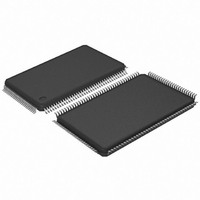AT91SAM7SE512-AU Atmel, AT91SAM7SE512-AU Datasheet - Page 398

AT91SAM7SE512-AU
Manufacturer Part Number
AT91SAM7SE512-AU
Description
IC ARM7 MCU FLASH 512K 128-LQFP
Manufacturer
Atmel
Series
AT91SAMr
Specifications of AT91SAM7SE512-AU
Core Processor
ARM7
Core Size
16/32-Bit
Speed
55MHz
Connectivity
EBI/EMI, I²C, SPI, SSC, UART/USART, USB
Peripherals
Brown-out Detect/Reset, POR, PWM, WDT
Number Of I /o
88
Program Memory Size
512KB (512K x 8)
Program Memory Type
FLASH
Ram Size
32K x 8
Voltage - Supply (vcc/vdd)
1.65 V ~ 1.95 V
Data Converters
A/D 8x10b
Oscillator Type
Internal
Operating Temperature
-40°C ~ 85°C
Package / Case
128-LQFP
Cpu Family
91S
Device Core
ARM7TDMI
Device Core Size
32b
Frequency (max)
55MHz
Interface Type
EBI/SPI/TWI/USART
Total Internal Ram Size
32KB
# I/os (max)
88
Number Of Timers - General Purpose
3
Operating Supply Voltage (typ)
1.8/3.3V
Operating Supply Voltage (max)
1.95/3.6V
Operating Supply Voltage (min)
1.65/3V
On-chip Adc
8-chx10-bit
Instruction Set Architecture
RISC
Operating Temp Range
-40C to 85C
Operating Temperature Classification
Industrial
Mounting
Surface Mount
Pin Count
128
Package Type
LQFP
No. Of I/o's
88
Ram Memory Size
32KB
Cpu Speed
48MHz
No. Of Timers
3
No. Of Pwm Channels
4
Digital Ic Case Style
LQFP
Rohs Compliant
Yes
Processor Series
AT91SAMx
Core
ARM7TDMI
Data Bus Width
32 bit
Data Ram Size
32 KB
Maximum Clock Frequency
48 MHz
Number Of Programmable I/os
32
Number Of Timers
3
Operating Supply Voltage
1.8 V to 3.3 V
Maximum Operating Temperature
+ 85 C
Mounting Style
SMD/SMT
3rd Party Development Tools
JTRACE-ARM-2M, KSK-AT91SAM7S-PL, MDK-ARM, RL-ARM, ULINK2
Development Tools By Supplier
AT91SAM-ICE, AT91-ISP, AT91SAM7SE-EK
Minimum Operating Temperature
- 40 C
For Use With
AT91SAM7SE-EK - EVAL BOARD FOR AT91SAM7SEAT91SAM-ICE - EMULATOR FOR AT91 ARM7/ARM9
Lead Free Status / RoHS Status
Lead free / RoHS Compliant
Eeprom Size
-
Lead Free Status / Rohs Status
Compliant
Available stocks
Company
Part Number
Manufacturer
Quantity
Price
Company:
Part Number:
AT91SAM7SE512-AU
Manufacturer:
AMTEL
Quantity:
382
Part Number:
AT91SAM7SE512-AU
Manufacturer:
ATMEL/爱特梅尔
Quantity:
20 000
- Current page: 398 of 673
- Download datasheet (11Mb)
33.6.2
33.6.3
33.6.3.1
398
SAM7SE512/256/32 Preliminary
Receiver and Transmitter Control
Synchronous and Asynchronous Modes
Transmitter Operations
Figure 33-5. Elementary Time Unit (ETU)
After reset, the receiver is disabled. The user must enable the receiver by setting the RXEN bit
in the Control Register (US_CR). However, the receiver registers can be programmed before the
receiver clock is enabled.
After reset, the transmitter is disabled. The user must enable it by setting the TXEN bit in the
Control Register (US_CR). However, the transmitter registers can be programmed before being
enabled.
The Receiver and the Transmitter can be enabled together or independently.
At any time, the software can perform a reset on the receiver or the transmitter of the USART by
setting the corresponding bit, RSTRX and RSTTX respectively, in the Control Register
(US_CR). The reset commands have the same effect as a hardware reset on the corresponding
logic. Regardless of what the receiver or the transmitter is performing, the communication is
immediately stopped.
The user can also independently disable the receiver or the transmitter by setting RXDIS and
TXDIS respectively in US_CR. If the receiver is disabled during a character reception, the
USART waits until the end of reception of the current character, then the reception is stopped. If
the transmitter is disabled while it is operating, the USART waits the end of transmission of both
the current character and character being stored in the Transmit Holding Register (US_THR). If
a timeguard is programmed, it is handled normally.
The transmitter performs the same in both synchronous and asynchronous operating modes
(SYNC = 0 or SYNC = 1). One start bit, up to 9 data bits, one optional parity bit and up to two
stop bits are successively shifted out on the TXD pin at each falling edge of the programmed
serial clock.
The number of data bits is selected by the CHRL field and the MODE 9 bit in the Mode Register
(US_MR). Nine bits are selected by setting the MODE 9 bit regardless of the CHRL field. The
parity bit is set according to the PAR field in US_MR. The even, odd, space, marked or none
parity bit can be configured. The MSBF field in US_MR configures which data bit is sent first. If
written at 1, the most significant bit is sent first. At 0, the less significant bit is sent first. The num-
ber of stop bits is selected by the NBSTOP field in US_MR. The 1.5 stop bit is supported in
asynchronous mode only.
ISO7816 I/O Line
ISO7816 Clock
on SCK
on TXD
ISO7816 Clock Cycles
FI_DI_RATIO
1 ETU
6222F–ATARM–14-Jan-11
Related parts for AT91SAM7SE512-AU
Image
Part Number
Description
Manufacturer
Datasheet
Request
R

Part Number:
Description:
EVAL BOARD FOR AT91SAM7SE
Manufacturer:
Atmel
Datasheet:

Part Number:
Description:
KIT EVAL FOR ARM AT91SAM7S
Manufacturer:
Atmel
Datasheet:

Part Number:
Description:
MCU, MPU & DSP Development Tools KICKSTART KIT ATMEL AT91SAM7S
Manufacturer:
IAR Systems

Part Number:
Description:
MCU ARM9 64K SRAM 144-LFBGA
Manufacturer:
Atmel
Datasheet:

Part Number:
Description:
IC ARM7 MCU FLASH 256K 100LQFP
Manufacturer:
Atmel
Datasheet:

Part Number:
Description:
IC ARM9 MPU 217-LFBGA
Manufacturer:
Atmel
Datasheet:

Part Number:
Description:
MCU ARM9 ULTRA LOW PWR 217-LFBGA
Manufacturer:
Atmel
Datasheet:

Part Number:
Description:
MCU ARM9 324-TFBGA
Manufacturer:
Atmel
Datasheet:

Part Number:
Description:
IC MCU ARM9 SAMPLING 217CBGA
Manufacturer:
Atmel
Datasheet:

Part Number:
Description:
IC ARM9 MCU 217-LFBGA
Manufacturer:
Atmel
Datasheet:

Part Number:
Description:
IC ARM9 MCU 208-PQFP
Manufacturer:
Atmel
Datasheet:

Part Number:
Description:
MCU ARM 512K HS FLASH 100-LQFP
Manufacturer:
Atmel
Datasheet:

Part Number:
Description:
MCU ARM 512K HS FLASH 100-TFBGA
Manufacturer:
Atmel
Datasheet:

Part Number:
Description:
IC ARM9 MCU 200 MHZ 324-TFBGA
Manufacturer:
Atmel
Datasheet:

Part Number:
Description:
IC ARM MCU 16BIT 128K 256BGA
Manufacturer:
Atmel
Datasheet:











